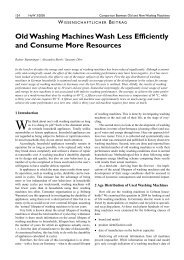Washing-up Behaviour and Techniques in Europe - Institute of ...
Washing-up Behaviour and Techniques in Europe - Institute of ...
Washing-up Behaviour and Techniques in Europe - Institute of ...
You also want an ePaper? Increase the reach of your titles
YUMPU automatically turns print PDFs into web optimized ePapers that Google loves.
031_Stamm<strong>in</strong>ger.qxp 27.02.2007 16:26 Seite 38<br />
38 HuW 1/2007 <strong>Wash<strong>in</strong>g</strong>-<strong>up</strong> behaviour<br />
Frequency<br />
25<br />
20<br />
15<br />
10<br />
5<br />
0<br />
W ISSENSCHAFTLICHER B EITRAG<br />
Figure 3: Histogram <strong>of</strong> time needed for all 113 manual washers<br />
100<br />
Detergent [<strong>in</strong> g]<br />
Source: Own data<br />
Figure 5: Histogram <strong>of</strong> achieved clean<strong>in</strong>g performances<br />
Frequency<br />
25<br />
20<br />
15<br />
10<br />
5<br />
0<br />
0.00 0.50 1.00 1.50 2.00 2.50 3.00 3.50 4.00 4.50<br />
-0.25 -0.75 -1.25 -1.75 -2.25 -2.75 -3.25 -3.75 -4.25 -4.75<br />
Clean<strong>in</strong>g <strong>in</strong>dex<br />
Source: Own data<br />
Score 0 means residues area > 200 mm 2 on all items; score 5 means no residues<br />
on any item.<br />
sponge type cloth are utilized. F<strong>in</strong>ally the c<strong>up</strong>s are<br />
washed.<br />
Observation: With the exception <strong>of</strong> a systematic<br />
soak<strong>in</strong>g the test person exhibits a rather<br />
thoughtless dish wash<strong>in</strong>g approach lead<strong>in</strong>g to a<br />
multiple change <strong>of</strong> dish water without produc<strong>in</strong>g a<br />
respective result.<br />
Characterization: Male British, over 40 years<br />
<strong>of</strong> age; total water consumption: 42.4 l; energy<br />
consumption: 0.78 kWh; accumulated dish wash<strong>in</strong>g<br />
time: 52 m<strong>in</strong>; detergent consumption: 16 g;<br />
clean<strong>in</strong>g <strong>in</strong>dex: 2.80.<br />
On the basis <strong>of</strong> the above, we conclude that<br />
there is no common dish wash<strong>in</strong>g practise <strong>in</strong><br />
<strong>Europe</strong>; neither can any clear preference for one<br />
technique or another be identified <strong>in</strong> any s<strong>in</strong>gle<br />
region.<br />
There are trends, however; for <strong>in</strong>stance, runn<strong>in</strong>g<br />
tap water seems to be used predom<strong>in</strong>antly <strong>in</strong><br />
southern <strong>Europe</strong>an countries (France be<strong>in</strong>g regarded<br />
as a southern country <strong>in</strong> this context), whereas<br />
runn<strong>in</strong>g tap water is only rarely used by test<br />
persons from <strong>Europe</strong>an countries further north.<br />
3.3 Measured performance <strong>and</strong> consumption<br />
<strong>of</strong> resources<br />
The large variety <strong>of</strong> habits f<strong>in</strong>ds expression <strong>in</strong><br />
the measured values <strong>of</strong> the water (Figure 1), energy<br />
(Figure 2), time (Figure 3) <strong>and</strong> cleanser (Figure<br />
4) used. Clean<strong>in</strong>g temperature ranged from cold<br />
water use <strong>up</strong> to 54 °C, the maximum temperature<br />
<strong>of</strong>fered for this test. An <strong>in</strong>dividual adjustment <strong>of</strong><br />
the clean<strong>in</strong>g temperature was done by most volunteers<br />
<strong>in</strong> mix<strong>in</strong>g cold <strong>and</strong> hot water s<strong>up</strong>ply.<br />
Statistical methods were used to identify significant<br />
differences between averages per region<br />
for each <strong>of</strong> the measured values <strong>and</strong> the volunteers’<br />
region <strong>of</strong> orig<strong>in</strong> (Table 8). Due to the relatively<br />
low number <strong>of</strong> participants, however, <strong>and</strong><br />
due to the large variety <strong>of</strong> practises with<strong>in</strong> each<br />
region, it is impossible to identify any clear clusters.<br />
Good <strong>and</strong> bad cleaners, savers <strong>and</strong> wasters<br />
can be found <strong>in</strong> all countries/regions.<br />
Almost no differences – <strong>and</strong> def<strong>in</strong>itely none <strong>of</strong><br />
statistical significance – can be observed between<br />
the averages measured for male or female test persons.<br />
Neither were there significant differences<br />
between the averages for younger <strong>and</strong> older test<br />
persons.<br />
Cleanness be<strong>in</strong>g the ma<strong>in</strong> aim <strong>of</strong> the whole<br />
dish wash<strong>in</strong>g process, the achieved clean<strong>in</strong>g performance<br />
is the most important measure for the<br />
whole wash<strong>in</strong>g-<strong>up</strong> process. With few exceptions,<br />
the test persons achieved clean<strong>in</strong>g performances<br />
between 2.5 <strong>and</strong> 4.5 on a scale from 0 to 5, where<br />
5 st<strong>and</strong>s for perfect cleanness. As there is no abso-





